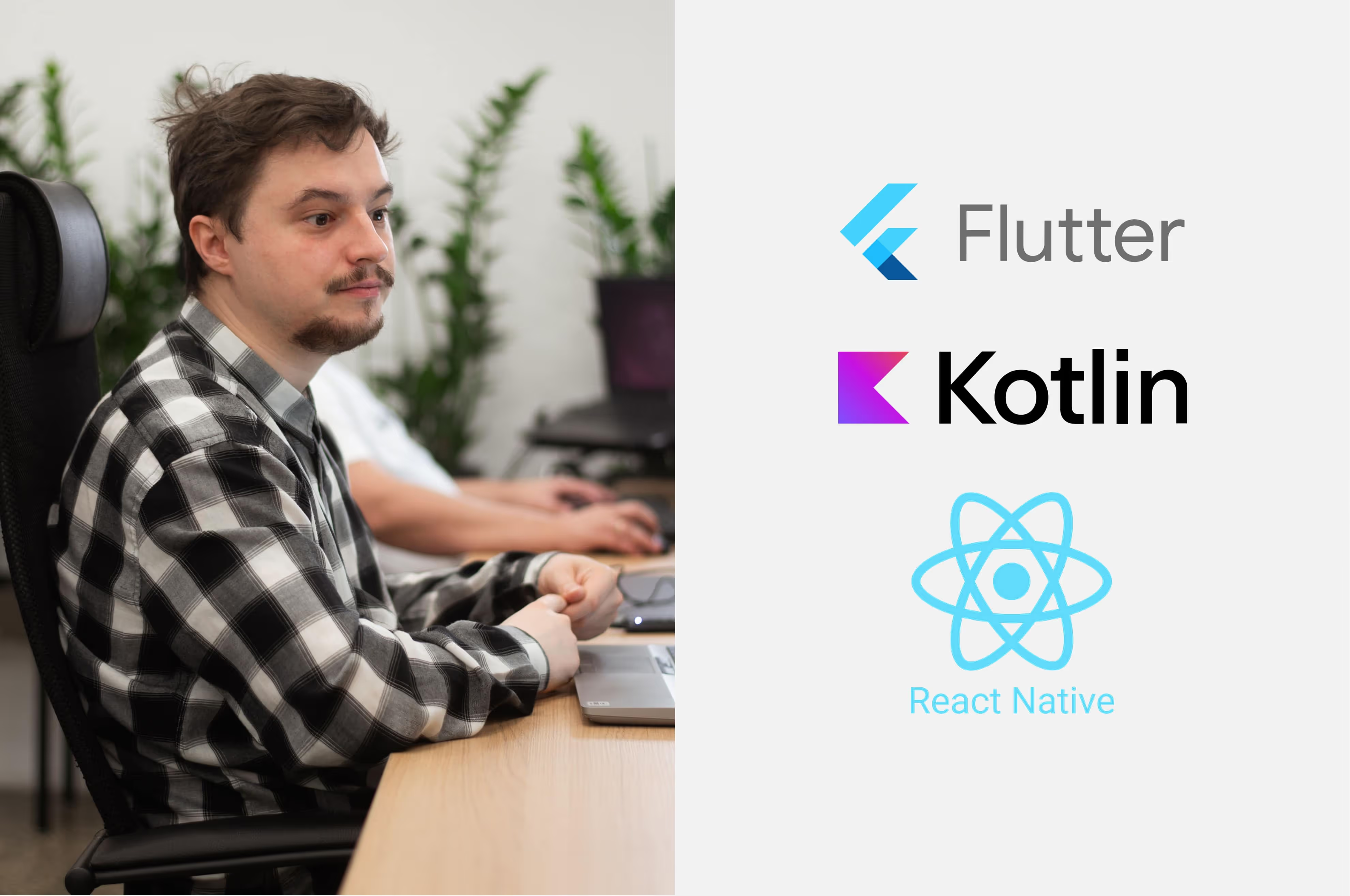When developing a mobile application, a business wants to get a multi-platform product with minimal costs and the fastest possible sales. A cross-platform application can solve this problem — and this is true both for client applications and in the case of applications designed to automate the company's internal processes.
Frameworks and programming languages designed to create multiplatform applications usually appear and develop with this goal setting. They form the basis for development, on which each new team adds its own code.
How do you choose the right tool to quickly create a stable application with high performance at minimal cost? In this article, KT.team experts compared the React Native and Flutter frameworks and the Kotlin programming language, assessing their simplicity, development speed, popularity (availability of developer services on the Russian market and the number of ready-made solutions for typical processes) and performance.
Quick facts about React Native, Flutter, and Kotlin
- React Native. It was created by Facebook in 2015. Simplifies mobile app development by allowing you to use the same code across platforms. It takes second place (42.62%) in the popularity rating of web frameworksused by developers. It has over 100,000 stars on GitHub. React Native apps: Facebook, Instagram, Skype, Tesla.
- Flutter. Google's free and open source framework. It was released in 2014 to create cross-platform mobile applications. More than 2 million developers choose Flutter, noting the high speed of development, rich functionality and the ability to create beautiful user interfaces. Over 150,000 stars on GitHub. Apps on Flutter: Alibaba.com, Birch Finance, Google Ads, Grab
- Kotlin. A programming language created by JetBrains in 2011. In 2017, Google announced Kotlin as the official programming language for Android. More than 60% of all developers use Kotlin, creating safe and efficient software with a minimum number of bugs. Kotlin apps: Coursera, Evernote, Pinterest, Trello, Uber.
Comparing React Native, Flutter, and Kotlin by key parameters
To choose the optimal technology for developing a mobile application, you need to compare them by key parameters.
Fast and easy development
The speed of development is influenced not only by the features of the technology itself, but also by the number of applications already created on it. The high popularity of a framework or language indicates the availability of an impressive number of ready-made solutions for typical application processes and tasks.
- React Native. The absolute leader due to the ability to write in JavaScript, which provides access to a vast pool of libraries and ready-made solutions, which significantly speeds up the development process. Moreover, after studying many successful React Native and JavaScript cases, developers are starting to quickly find solutions to complex technical problems that often arise during development. KT.team's employees' portfolio also includes projects developed on React Native, for example corporate application for receiving materials at construction sites.
- Flutter. It uses Material Design to create UI solutions and allows you to upload changes to the application almost instantly without recompilation, reducing development time. It's also a great option for developing a cross-platform mobile (Android and iOS) and web app — you only need one backend. However, Flutter is still inferior to React Native in the convenience of creating Android and iOS solutions with complex UI, where you will have to add different code for each platform.
- Kotlin. Perhaps one of the most comfortable languages for developing mobile applications with a simple and intuitive architecture, as well as a large range of features and tools. Developers who have experience with Java will like the language structure. However, compared to React Native and Flutter, Kotlin has the slowest process to build an app, which can make it take longer to set up the project initially.
Development cost
The more expensive developer services are, the higher the cost of developing a mobile app — and vice versa. In the context of frameworks, you should also take into account the prices for the services of specialists who work with the programming languages used for each framework. In terms of the cost ratio of solutions, our rating — from low to high prices — is as follows.
- React Native is the cheapest alternative, mainly due to the moderate cost of JavaScript developer services and their availability on the Russian market. On average the work of a React Native specialist will cost 197 thousand rubles per month (data as of April 2023). However, compared to other options, React Native is often more profitable, as businesses recruit competent specialists faster due to the popularity of the framework and JavaScript, and can also quickly get a cross-platform application.
- Flutter it is reasonable to place it in second place, given the affordable cost of developer services and the ability to create a multi-platform application for mobile and web platforms. On average A Flutter developer can earn 191 thousand rubles per month (probably due to relatively low demand on the Russian market).
- Kotlin will be the most expensive alternative for several reasons. Firstly, it is only suitable for Android development, which means that a request for cross-platform functionality will force you to spend on an additional team. Second, A Kotlin developer earns an average of about 253,000 rubles per month.
The popularity of the technology
The more popular a technology is, the more extensive its community and better support. In development, this means finding affordable solutions faster, better security and stability.
- Flutter gradually won first place in the ranking of multiplatform mobile frameworks: according to Statista, 42% of the world's developers used it in 2021, which is 4% more than React Native. However, their confrontation continues, given that 16.48% of professional developers preferred React Native, while only 13.35% chose Flutter.
- React Native It takes a confident second place, as the demand for the framework in cross-platform mobile development has begun to decline in recent years. According to Statista, mentioned above, 42% of developers used it in 2019-2020, and 38% in 2021.
- Kotlin, as the youngest technology, is only gaining momentum. According to Statista, in 2022, only 9.16% of developers used it. A similar result is presented in the Stack Overflow Developer Survey 2021: 9.09% of IT professionals admitted that they love working with Kotlin.
Productivity
Let's be honest: cross-platform solutions will never reach the level of native development performance. In other words, the processing speed of user requests and the degree of stability of the application will always be slightly worse, since the range of opportunities for creating multiplatform applications is limited.
In view of the above, we should assess how close cross-platform technologies can get to native development indicators.
- Flutter is able to give high-quality results even in complex projects, because it allows you to create large-scale resource-intensive applications without losing query processing speed. Another advantage is the availability of our own UI rendering engine, which helps to get a smooth and responsive interface.
- On Kotlin You can create high-performance Android applications using a convenient system of modules and integration with native APIs that provide the ability to interact directly with native Android components. Of course, this will take more time during the development process, but it will allow you to use the device's resources as efficiently as possible.
- React Native is inferior to both alternatives, sacrificing performance in favor of simplicity and availability, which can contribute to delays when loading and rendering components. Try not to skimp on experienced developers if you plan to create a complex or resource-intensive application, and you will be pleased with the result.
findings
The choice of a framework or language directly depends on your business goals. If you need to build a relatively simple application quickly and inexpensively, you should choose React Native. Given the great popularity of JavaScript, finding an IT specialist won't take much time, just like the development process itself (due to its simplicity and accessibility).
If you need a stable, high-performance application that can handle tens of thousands of users and quickly process their requests, consider Kotlin and Flutter. This will take a longer and more expensive process, but you will end up with a high-tech solution with a level of performance close to the native one.
If you are not sure which framework or language is right for your tasks, consult an IT company that has experience in implementing projects using all three technologies and is able to give unbiased advice based on its own practice.







